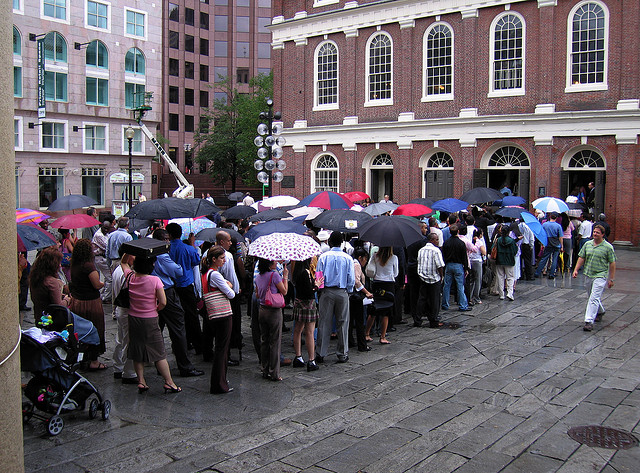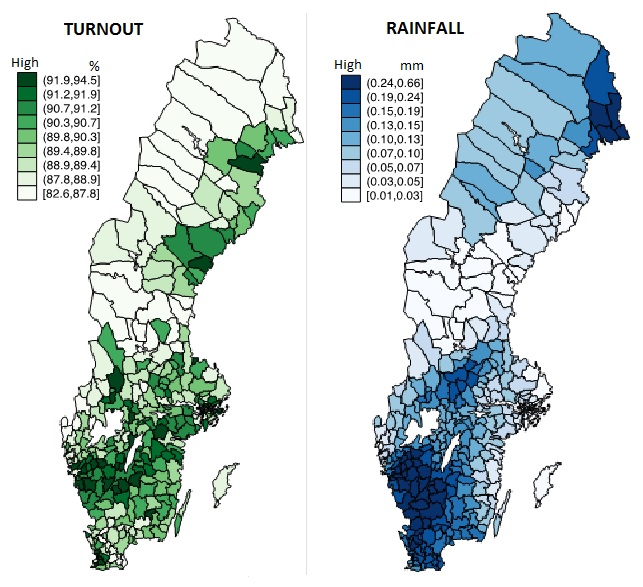The weather does not affect voter turnout, but only if voting is convenient for the public
The Police and Crime Commissioner elections of 2012 were marked by extraordinarily low voter turnout, with speculation that holding the election in November meant poor weather would have reduced participation. Mikael Persson, Anders Sundell and Richard Öhrvall have studied this phenomenon in Swedish elections, and found the weather has no significant impact on turnout. However, comparison with the United States suggests that the weather may have a greater impact where election procedures are less convenient.
Evidence from Sweden suggests the weather does not affect turnout. Credit: David Thompson, CC BY-SA-NC 2.0
“Terrible voting weather, remarked the presiding officer of polling station fourteen as he snapped shut his soaked umbrella…”
So begins the novel Seeing by Nobel laureate José Saramago. The presiding officer, together with representatives of the political parties, awaits the voters at a polling station in the city, amidst rainfall of biblical proportions. When the polling station opens, no voters appear, as seen on the book’s cover.
According to a widespread belief, as frequently expressed in news media and among academics, rainfall on Election Day is expected to lower voter turnout. For instance, when elections for Police commissioners were held for the first time in the UK in 2012 there was speculation that the British autumn weather would affect turnout adversely, and turnout was eventually only a meagre 15 percent.
Was the weather to blame? We have no such evidence but we can learn a few things about the impact of weather on voting from previous research.
A handful of studies provide solid empirical evidence on the impact of rain on voting. In the most sophisticated analysis to date, Gomez, Hansford and Krause show that one inch of rain reduces turnout with about one percentage point in US presidential elections. This is a small, but statistically significant effect. They also argue that republicans benefit from rainfall during election day, since democrats are more likely to abstain from voting when it rains. However, as said before, the effect found is small, but still big enough to have an impact on close elections. In fact, they go as far as saying that if it had rained less in 2000, Al Gore would have won Florida and become the president of the United States instead of George Bush.
The underlying principle for the hypothesis that rainfall affects turnout is that voters assess the costs and benefits associated with voting. If the benefits outweigh the costs, individuals will cast their votes and if not they will abstain. However, the previous studies on the impact of rain during Election Day mostly focus on turnout in the United States, a country where the costs associated with voting are high in a comparative perspective. Hence, we do not know anything about the generalizability of these findings: can the negative effects of rain on voter turnout also be found in other contexts where the costs of voting are substantially lower?
In a study which is forthcoming in Electoral Studies we analyse the possible impact of rainfall on voter turnout in Swedish parliamentary elections. Sweden is an interesting country to use as a comparison to the US since turnout levels are consistently higher, the costs of voting are lower and the benefits are likely to be perceived as higher (election day is on a weekend, no registration is required, etc.)
We test the impact of rainfall on three different datasets that allows us to view the issue both from a wide time frame and with high precision as for turnout measures. We use data on aggregate levels of turnout in Swedish municipalities. In addition, we also present results from two individual-level datasets covering more than 150,000 individuals. We use measures of election day rain from about 750 whether stations in all Sweden’s 290 municipalities during the period 1976-2010 (interpolated to each location using Geographical Information System software) and estimate the effects on official turnout levels from municipalities and individual level voting (validated with official census registers). No previous study on rain and voting has drawn on such diverse datasets to support its conclusions.
Using a large number of statistical tests and robustness checks, we fail to find any significant effect of rain on voter turnout in Sweden. Even when using datasets covering almost 150,000 persons and very detailed rain data, we do not find any meaningful effects of weather conditions. For example, the maps present rainfall (green map) and turnout (blue map) in Swedish municipalities in the year during which there were heaviest rain on election day, 1985. Darker greens and blues represent more rainfall and turnout respectively. There is no visible indication that turnout was lower in the municipalities where there were most rain.
Figure 1
How come the weather does not seem to impact voting in Sweden? We can only speculate, but it seems reasonable to assume that the lower costs of voting in Sweden play a significant role. The absence of registration requirements and the fact that voting takes place on a Sunday, enables voters plenty of opportunity to vote. In contrast, as Election Day in the US always is a Tuesday, a workday, voters probably have less time to vote, for instance on the way home from work. Whereas voters in Sweden can wait for the rain to stop, their American counterparts may not have the same option.
To conclude, in a country like Sweden the weather seems to have a negligible, if any, effect on voter turnout. Moreover, the existing research has only found a very small negative effect. So, did José Saramago misjudge the voters, then? Did he really believe them to abstain from choosing their government due to fear of getting wet? No. Until four o’clock in the afternoon, only a few voters come to the polling station, but then the electorate of Saramago’s unnamed city turned up:
“…all of them, absolutely all of them, the healthy and the infirm, the former on foot, the latter in wheelchairs, on stretchers, in ambulances, headed straight for their respective polling stations like rivers which know no other course than that which flows to the sea.”
–
Note: This post represents the views of the authors, and does not give the position of Democratic Audit or the LSE. Please read our comments policy before commenting. Shortlink for this post: buff.ly/19U4M50
–
 |
Mikael Persson is a researcher and lecturer at the Department of political science, University of Gothenburg. |
 |
Anders Sundell is a PhD candidate at the Department of political science, University of Gothenburg. |
 |
Richard Öhrvall is researcher at the Research Institute of Industrial Economics, a statistician at Statistics Sweden and a PhD candidate at Linköping University. |







 Democratic Audit's core funding is provided by the Joseph Rowntree Charitable Trust. Additional funding is provided by the London School of Economics.
Democratic Audit's core funding is provided by the Joseph Rowntree Charitable Trust. Additional funding is provided by the London School of Economics.
“For example, the maps present rainfall (green map) and turnout (blue map) in Swedish municipalities in the year during which there were heaviest rain on election day, 1985.”
The keys to the maps seem to say the opposite!
Does the weather affect voter turnout? https://t.co/SASzJ2rkiE
The weather and politics. UK ?
“@democraticaudit: Swedes vote in the rain. Americans don’t. Find out why. https://t.co/bnDfnmav4X”
Rain-no impact on voting in Sweden
“@democraticaudit: Swedes vote in the rain. Americans don’t. Find out why. https://t.co/xOjVXsYjbz”
Swedes vote in the rain. Americans don’t. Find out why. https://t.co/h9IlYtLVCf
“We can only speculate, but it seems reasonable to assume that the lower costs of voting in Sweden play a significant role.”
Without further data we can only speculate:
Will people be more likely to vote in bad weather if they think their vote will make a difference? (Sweden has a form of proportional representation – so it is reasonable to suppose that voting is more meaningful.)
Is there any analysis of UK turnout vs weather categorised according to how marginal seats are?
Thanks for the comment. You are probably right to suggest that under FPTP, if you live in a safe seat you are more likely to feel it is not worth going out in bad weather to vote. We don’t know of any research into this in the UK, however. Of course there are ways to take the weather out of the electoral equation altogether, like e-voting.
“Of course there are ways to take the weather out of the electoral equation altogether, like e-voting.”
E-voting of course takes out transparency and confidence in the security of voting – never mind issues of digital exclusion. (I find the security of e-voting for my building society directors laughable – “for security” my voting ID is formed of two “separate” numbers – printed on the same piece of letter. Short of embedding some form of ID chip in my “voting finger”, how can be we sure of who is voting without some form of national ID system)
On-line voting means trusting the entire system. The Americans have enough problems with their voting machines! Ballot papers have a lot going for them. (see https://enfranchiseme.wordpress.com/2013/06/11/on-line-voting/ )
Politicians think it is bad when we do not trust them – it will be far worse if we cease to trust the mechanism that elects them.
You might be interested in this post by Andy Williamson: https://www.democraticaudit.com/?p=1403. Have to say I don’t share your pessimism about e-voting systems being insecure – certainly no less secure than the current system assuming the right safeguards are in place.
Per Andy Williamson (thanks for link)
“the biggest challenge to 21st century voting technology in ID-averse UK will be verification!”
Trust in the political process is currently fragile. We need to be very careful that in our efforts to increase turnout by tinkering with the voting process we do not further damage that trust.
Two strengths of the current system that we need to protect:
– with voting in person, you present yourself at the polling station and the polling clerk “marks you off” and can see that you are not voting under pressure from anyone else. With voting in absentia (paper or electronic) we have no way of knowing who filled in the ballot and whether they were under pressure. “Marking off” on the register is not a particularly good way of preventing impersonation, but at least you have to be sure that any person whose vote you wish to steal will not turn up later and you do at least have to be of approximately the right gender (unless the polling clerk is very dozy).
– with paper ballots going into sealed boxes which are then escorted under police supervision to counting stations where they are counted in front of representatives of the parties there is great visibility. The numbering of ballot papers does at least allow the courts to see a full audit trail. Stories of faulty voting machines in the USA and problems with security of large government systems make many nervous of abandoning a system which is slow but sure.
MT @richard3berry: This @democraticaudit blog post could be really topical, if only it hadn’t stopped raining today https://t.co/oczjEBKTSv
This @democraticaudit blog post could be really topical, if only it hadn’t stopped raining today https://t.co/uq9uxrYkPw (on voter turnout)
Interesting – does the weather really affect electoral turnout? @democraticaudit
https://t.co/j6UgB0I84c
Bad weather only has an effect on election turnout if the voting process is inconvenient for voters as in US (or UK) https://t.co/uoQw8mFGGi
The weather does not affect voter turnout, but only if voting is convenient for the public https://t.co/12z4r9DoSs